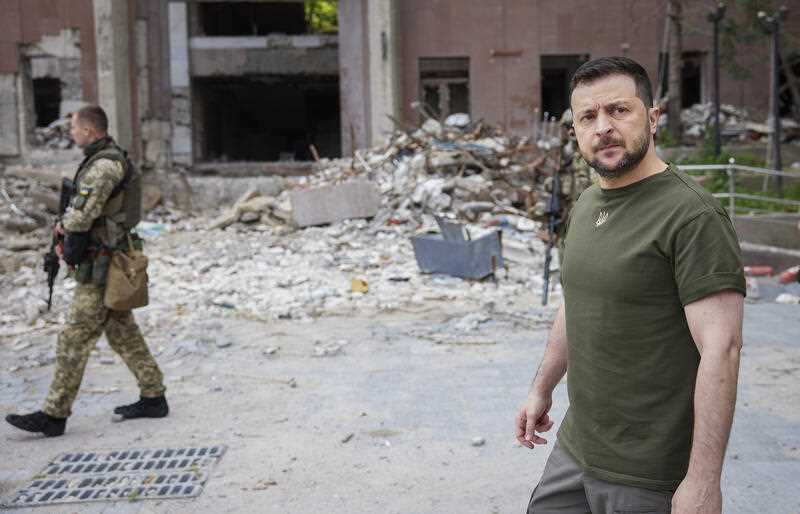The war in Ukraine could last for years, the head of NATO says, as Russia stepped up its assaults after the European Union recommended that Kyiv become a candidate to join the bloc.
Jens Stoltenberg said the supply of state-of-the-art weaponry to Ukrainian troops would boost the chance of freeing its eastern region of Donbas from Russian control, Germany’s Bild am Sonntag newspaper said.
“We must prepare for the fact that it could take years. We must not let up in supporting Ukraine,” Stoltenberg, the secretary-general of the military alliance, was quoted as saying on Sunday.
“Even if the costs are high, not only for military support, also because of rising energy and food prices.”
British Prime Minister Boris Johnson, who visited Kyiv on Friday, also spoke of a need to prepare for a long war.
This meant ensuring “Ukraine receives weapons, equipment, ammunition and training more rapidly than the invader”, Johnson wrote in an opinion piece in London’s Sunday Times.
“Time is the vital factor,” he wrote. “Everything will depend on whether Ukraine can strengthen its ability to defend its soil faster than Russia can renew its capacity to attack.”
Ukraine received a significant boost on Friday when the European Commission recommended it for candidate status, a decision EU nations are expected to endorse at a summit this week.
That would put Ukraine on course to realise an aspiration seen as out of reach before Russia’s February 24 invasion, even if membership could take years.
Russian attacks intensified on Ukraine’s battlefields.
The industrial city of Sievierodonetsk, a prime target in Moscow’s offensive to seize full control of Luhansk – one of the two provinces making up the Donbas – faced heavy artillery and rocket fire again, the Ukrainian military said.
“The situation in Sievierodonetsk is very difficult,” said Serhiy Gaidai, the Ukrainian-appointed governor of Luhansk, adding that Russian forces, using drones for air reconnaissance, were adjusting strikes quickly in response to defence changes.
“Areas near the bridges have been heavily shelled again,” Gaidai said in an online post on Sunday, adding that the Azot chemical plant, where hundreds of people had been sheltering, was hit twice.
“Fighting continues for full control of the city,” the general staff of the Ukrainian armed forces said in a daily update on Sunday.
Analysts at the Washington Institute for the Study of War think tank wrote that “Russian forces will likely be able to seize Sievierodonetsk in the coming weeks, but at the cost of concentrating most of their available forces in this small area”.
In Sievierodonetsk’s twin city Lysychansk across the river, the bodies of two civilians had been found, Gaidai said, adding, “The destruction of housing in the city is increasing like an avalanche.”
Ukraine’s military acknowledged that “the enemy has partial success in the village of Metolkine”, just southeast of Sievierodonetsk.
Two top commanders of fighters who defended the Azovstal steel plant in the southeastern port of Mariupol have been transferred to Russia for investigation, TASS said.
Ukrainian President Volodymyr Zelenskiy, whose defiance has inspired his people and won global respect, said he had visited soldiers on the southern frontline in the Mykolaiv region, about 550 km south of Kyiv.
“I talked to our defenders – the military, the police, the National Guard,” he said in a video on the Telegram message app on Sunday that appeared to have been recorded on a moving train.
“Their mood is assured: they all do not doubt our victory,” Zelenskiy said. “We will not give the south to anyone, and all that is ours we will take back.”
Another video showed Zelenskiy in his trademark khaki T-shirt handing out medals and posing for selfies with servicemen.
Zelenskiy has stayed mostly in Kyiv since Russia invaded, although in recent weeks he has made unannounced visits to Kharkiv and two eastern cities near battles.
One of Russian President Vladimir Putin’s stated goals in ordering troops into Ukraine was to halt the eastward expansion of the North Atlantic Treaty Alliance and keep Moscow’s southern neighbour outside the West’s sphere of influence.
But the war, which has killed thousands, reduced cities to rubble and sent millions fleeing, has had the opposite effect – convincing Finland and Sweden to seek to join NATO – and helping to pave the way for Ukraine’s EU membership bid.
By Pavel Polityuk and Max Hunder in KYIV



